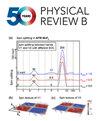弱莫特绝缘体中量子自旋液体的电场控制
IF 3.7
2区 物理与天体物理
Q1 Physics and Astronomy
引用次数: 0
摘要
强耦合条件下的三角形晶格哈伯德模型的有效自旋模型包含海森堡和环交换相互作用,随着跳变 t 与现场库仑斥力 U 之比的调整,该模型展现出丰富的相图。其中包括手性自旋液体(CSL)相。然而,由于给定材料的 t/U 值是固定的,很难通过外部刺激进行调整,因此要在实验中实现这种奇异的相位仍然具有挑战性。解决这一问题的方法之一是施加直流电场,当电子经历虚拟跳跃过程时,该电场会使交换相互作用重新规范化;除了创建虚拟双占据位点外,电子还必须克服电势能差。通过小 t/U 扩展到四阶,我们推导出了存在电场时的环交换模型,发现电场不仅引入了空间各向异性,而且与占主导地位的近邻海森堡相互作用相比,还倾向于增强环交换项。因此,在 t/U 不变的情况下,增加电场可以提高环交换的重要性。通过密度矩阵重正化群计算,我们计算了两种不同电场方向的环交换模型基态相图。在这两种情况下,我们都发现电场会使 CSL 的相边界向较小的 t/U 比值移动。因此,电场可以将磁有序态驱动到 CSL 中。这一明确的证明为通过施加电场将其他量子自旋系统调谐为自旋液相打开了大门。本文章由计算机程序翻译,如有差异,请以英文原文为准。

Electric field control of a quantum spin liquid in weak Mott insulators
The triangular lattice Hubbard model at strong coupling, whose effective spin model contains both Heisenberg and ring exchange interactions, exhibits a rich phase diagram as the ratio of the hopping to on-site Coulomb repulsion is tuned. This includes a chiral spin liquid (CSL) phase. Nevertheless, this exotic phase remains challenging to realize experimentally because a given material has a fixed value of , which is difficult to tune with external stimuli. One approach to address this problem is applying a dc electric field, which renormalizes the exchange interactions as electrons undergo virtual hopping processes; in addition to creating virtual doubly occupied sites, electrons must overcome electric potential energy differences. Performing a small expansion to fourth order, we derive the ring exchange model in the presence of an electric field and find that it not only introduces spatial anisotropy but also tends to enhance the ring exchange term compared to the dominant nearest-neighbor Heisenberg interaction. Thus, increasing the electric field serves as a way to increase the importance of the ring exchange at constant . Through density matrix renormalization group calculations, we compute the ground-state phase diagram of the ring exchange model for two different electric field directions. In both cases, we find that the electric field shifts the phase boundary of the CSL towards a smaller ratio of . Therefore, the electric field can drive a magnetically ordered state into the CSL. This explicit demonstration opens the door to tuning other quantum spin systems into spin liquid phases via the application of an electric field.
求助全文
通过发布文献求助,成功后即可免费获取论文全文。
去求助
来源期刊

Physical Review B
物理-物理:凝聚态物理
CiteScore
6.70
自引率
32.40%
发文量
0
审稿时长
3.0 months
期刊介绍:
Physical Review B (PRB) is the world’s largest dedicated physics journal, publishing approximately 100 new, high-quality papers each week. The most highly cited journal in condensed matter physics, PRB provides outstanding depth and breadth of coverage, combined with unrivaled context and background for ongoing research by scientists worldwide.
PRB covers the full range of condensed matter, materials physics, and related subfields, including:
-Structure and phase transitions
-Ferroelectrics and multiferroics
-Disordered systems and alloys
-Magnetism
-Superconductivity
-Electronic structure, photonics, and metamaterials
-Semiconductors and mesoscopic systems
-Surfaces, nanoscience, and two-dimensional materials
-Topological states of matter
 求助内容:
求助内容: 应助结果提醒方式:
应助结果提醒方式:


